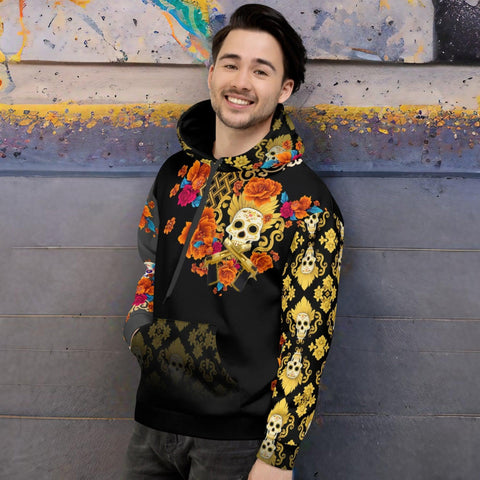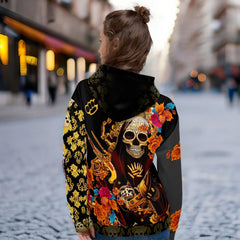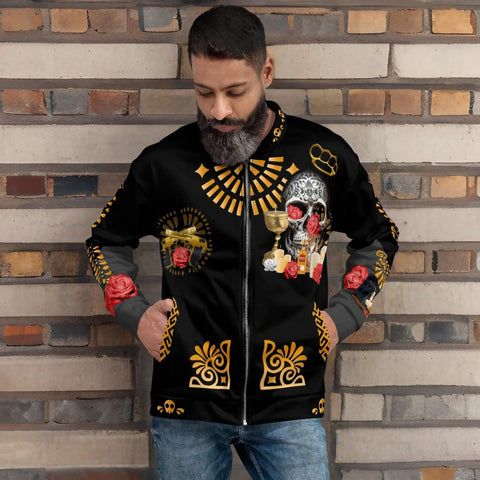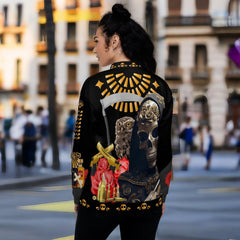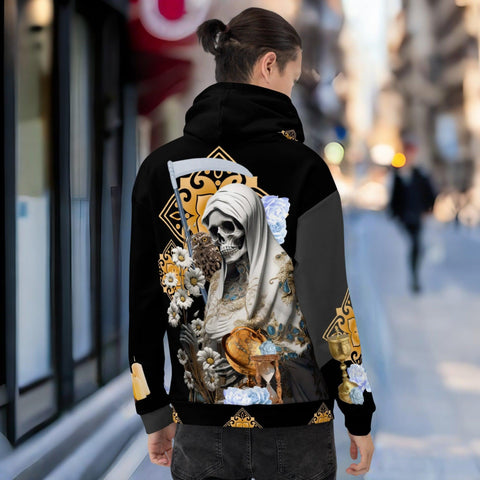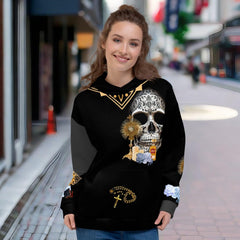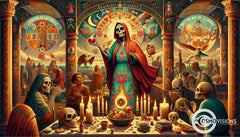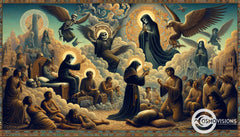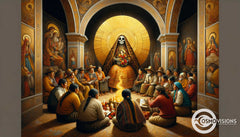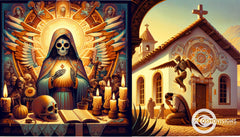The Interplay of Day of the Dead and Santa Muerte Religion
Posted by Luciano Martucci
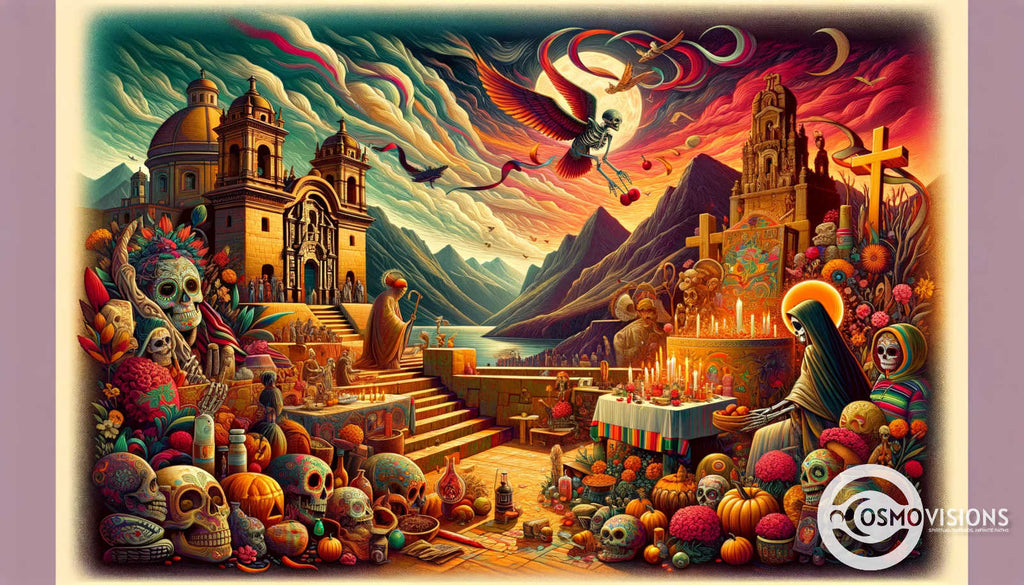
In the swirling colors and vibrant traditions of Mexico, two powerful symbols stand out: Santa Muerte and the Day of the Dead. People from all over find themselves drawn to these celebrations but often get tangled in understanding their origins or meanings.
Are they part of the same tradition? Why do people venerate a saint that represents death? These questions echo in the minds of many who are captivated by Mexican culture.
One fascinating fact is that though they share themes, Santa Muerte and Day of the Dead hail from different roots. The Day of the Dead predates Spanish colonization while Santa Muerte's public devotion has surged just recently.
This post will unravel this mystifying interplay, offering clarity to those intrigued by these practices. You'll discover how each tradition adds unique threads to Mexico's cultural tapestry as well as their influence beyond borders.
Get ready for an enlightening journey through history, belief, and celebration!
Understanding Santa Muerte
Santa Muerte, also known as Holy Death, is a folk saint and personification of death that has gained popularity in Mexico and among Mexican and Central American immigrants in the United States.
She is often depicted as a skeletal figure carrying a scythe, similar to the Grim Reaper. Worshipers venerate her for protection, healing, and justice.
History and Origin
Santa Muerte's history is a tapestry woven from indigenous Mesoamerican beliefs intertwined with European Christianity. The figure may trace its roots back to the veneration of death by the Aztecs, suggesting continuity between ancient traditions and contemporary practices.
This folk saint embodies both worlds, reflecting centuries of cultural syncretism through her devotees' rituals and iconography.
Iconic symbols associated with Santa Muerte often contain hints at her historical origins. Her imagery fuses elements from Precolumbian times, such as skull motifs and offerings, with European-influenced attributes like robes and scythes.
These blend within Latin American contexts to shape a unique spiritual entity that speaks deeply to those who feel aligned with her persona. Santa Muerte stands not just as death personified but also as a mirror reflecting a diverse heritage stretching across civilizations and ages.
Attributes and Iconography
Transitioning from the roots of Santa Muerte, her attributes and iconography reveal a rich tapestry of cultural influences. She often appears as a robed skeleton, wielding a scythe or globe, embodying both creation and destruction.
Her portrayal draws from Precolumbian ideals about death and rebirth as well as European symbols of justice and time’s passage.
Devotees see many facets in her image: some associate her with protection; others seek fortune or love under her gaze. The colors adorning her effigies carry specific meanings—red for passion, white for purity, and black for protection against negativity.
Each element found on altars dedicated to la Parca is meaningful and carefully chosen to reflect the desires and gratitude of those who venerate this folk saint.

Places of Worship
Moving from the visual depictions of la Santa Muerte, followers bring their reverence into various sanctuaries. Devotees often establish altars in their own homes, creating personal shrines adorned with symbols of the bony lady.
These spaces become central to daily prayers and offerings, reflecting a deep spiritual connection within private confines.
Outside these intimate settings, Santa Muerte's presence spans across public shrines and temples dedicated solely to her veneration. The flexibility of worship allows for communal gatherings at outdoor events or community centers where rituals unfold amidst collective energy.
Whether in secluded home chapels or amid bustling public ceremonies, devotees find solace and empowerment through these diverse places of adoration.
Rituals and Veneration
Santa Muerte's followers conduct various rituals to venerate the saint and seek her protection. These practices are deeply rooted in both Indigenous death worship and Catholic traditions, reflecting a unique blend of spiritual influences. Here are some key rituals and aspects of veneration associated with Santa Muerte:
- Placing statues of Santa Muerte in homes as a focal point for devotion, featuring different colored robes to signify different requests or intentions, such as red for love and passion, white for peace and harmony, and green for justice and legal matters.
- Offering various items to Santa Muerte, such as candles, incense, fresh flowers, fruits, alcohol, tobacco, or other symbolic objects to honor her and seek her favor.
- Conducting prayers and devotions to the saint at home altars or public shrines, often involving reciting specific prayers or novenas corresponding to different petitions or needs.
Prayers and Devotions to Santa Muerte
Followers of Santa Muerte engage in various prayers and devotions, including lighting candles as offerings. They may also recite specific prayers or novenas to ask for protection, health, or prosperity.
Santa Muerte's Role in Society
Santa Muerte plays a significant role in Mexican society, where she is often associated with marginalized groups such as the LGBTQ+ community and individuals involved in criminal activities.
Despite opposition and persecution from the Catholic Church, her veneration continues to grow as people turn to her for protection and guidance.

Association with the LGBTQ+ Community
Santa Muerte has a strong following within the LGBTQ+ community, attracting millions of devotees. The skeleton saint provides solace and protection against both church and state for marginalized groups, including LGBTQ migrants.
Santa Muerte's cult has become a source of spiritual support for many members of the LGBTQ+ community, offering acceptance and understanding in the face of societal challenges.
Devotees from different walks of life, including those identifying as LGBTQ+, seek comfort and empowerment in Santa Muerte's veneration. This aspect makes her an important figure within diverse communities where individuals find strength and belonging through her worship.
Connection with Criminality
Santa Muerte's connection with criminality is well-documented, as law enforcement often finds Santa Muerte artifacts at crime scenes. This association extends to narco-culture, where elements of Palo Mayombe have been integrated into Santa Muerte worship.
Raids on narco safehouses have led to the discovery of shrines and other religious paraphernalia linked to Santa Muerte.
The integration of such elements continues to be a point of concern, especially in relation to criminal activities associated with these groups. The complex interplay between spiritual practices and criminal behavior adds another layer to understanding the role and impact of Santa Muerte in society.
Opposition and Persecution
Santa Muerte faces opposition and persecution, particularly from the Catholic Church. It is condemned as satanic and closely associated with the lower classes and criminal elements in Mexico.
This has led to Santa Muerte being viewed with suspicion and disdain by traditional religious authorities, contributing to its marginalized status within mainstream society.
The veneration of Santa Muerte perfectly embodies opposition to contemporary US responses to undocumented migrants, reflecting historic church and state dynamics. Additionally, the strong connection between Santa Muerte and criminality further exacerbates the opposition against this spiritual practice.
These factors have fueled ongoing persecution of Santa Muerte practitioners, making it a contentious issue that continues to provoke debate across different segments of society.
Santa Muerte and the Day of the Dead
While both Santa Muerte and the Day of the Dead are related to death and Mexican culture, they have distinct beliefs, practices, and significance. The interplay of these two traditions during Dia de los Muertos showcases the complex cultural tapestry of Mexico and its spiritual practices.
Similarities and Differences
The Day of the Dead and Santa Muerte both involve reverence for death, but their historical origins and cultural significance differ. The Day of the Dead is a traditional Mexican festival with pre-Columbian roots, celebrated nationwide as a way to honor deceased ancestors.
On the other hand, Santa Muerte's cult is a modern-day adoration of the figure of the Holy Death, deeply rooted in Mexico's lower classes and intertwined with criminal elements. While both are significant in Mexican culture, they convey distinct religious and cultural meanings.
Despite both honoring death, Santa Muerte represents an alternative veneration that stands apart from the more widespread celebration of Dia de los Muertos throughout Mexico. This distinction reflects varying cultural practices within Mexican society — one grounded in ancient traditions and communal celebrations (Dia de los Muertos), while the other has emerged as a marginalized but increasingly popular spiritual movement (Santa Muerte).
The Interplay of Cultures on Dia de los Muertos
The interplay of cultures on Dia de los Muertos is a fascinating blend of indigenous Mesoamerican traditions with Catholic rituals brought by the Spanish conquistadores. This unique fusion showcases the syncretism between pre-Hispanic beliefs and European practices, resulting in vibrant and colorful festivities that honor deceased loved ones.
With offerings of marigolds, sugar skulls, and pan de muerto, families create altars to welcome back the spirits during this time of remembrance.
In addition to these customs, Santa Muerte religion's influence can be seen during Dia de los Muertos celebrations. The veneration of Santa Muerte as a folk saint demonstrates how diverse belief systems have intertwined within Mexican culture over generations.

Santa Muerte in the United States
Santa Muerte's followers in the United States have increased, highlighting the influence of Mexican culture and religion in the US. The devotion to Santa Muerte has extended beyond Mexico, shaping a growing community of worshippers in American cities.
Immigration to and return from the United States have played significant roles in spreading Santa Muerte's veneration.
With its presence expanding across borders, Santa Muerte has become an integral part of religious practices for many communities in the United States. The interaction between Mexican and American cultures continues to shape the way this death saint is revered within the context of different societies.
The Day of the Dead Festival
Originating from the indigenous Aztec tradition and influenced by Catholicism, the Day of the Dead festival is a vibrant celebration that honors deceased loved ones through colorful altars, traditional food, and festive gatherings.
To learn more about this rich cultural event and its interplay with Santa Muerte religion, dive deeper into our blog.
Origin and History
The Day of the Dead, also known as Día de los Muertos, has origins in the Indigenous death worship and Catholic traditions. It is a vibrant festival that blends Mesoamerican rituals, European religion, and Spanish culture.
The celebration takes place from October 31 to November 2 each year, encompassing both tangible and intangible traditions from pre-Hispanic cultures. Veneration of ancestors lies at the heart of this festival, embodying an interplay of diverse cultural influences that have shaped this unique tradition.
Moving on to "Traditions and Celebrations" - let's explore in detail how these cultural influences manifest during the Day of the Dead festivities!
Traditions and Celebrations
The Day of the Dead festival is a vibrant and colorful celebration that combines Indigenous death worship with Catholic practice.



